
Drone technology helps golf course superintendents spot problems on the green before they become visible and address them proactively without players ever noticing. Angel Eyes UAV pairs DroneDeploy with the Turf.Solutions app to identify green maintenance issues early and reduce treatment times by up to 96%.
Golf is a sport of precision; every stroke counts. Because of this, a healthy, uniform green isn’t just a matter of good aesthetics—it is an integral part of the game.

When Florida-based Stephen Myers sold his managed IT services firm three years ago, he decided he wanted to spend the next phase of his life flying around the country to play golf. He just needed to figure out how to make a living doing it. So the corporate pilot, and single-digit handicap golfer, turned to drone technology.
“It was a matter of being opportunistic in my surroundings,” says Stephen. “With my background in data and expertise in airspace and aircraft, it was a natural fit.”
In 2013, Stephen launched Angel Eyes UAV to help golf courses, as well as engineering firms and construction companies, gather and analyze data using drone technology. The company uses DroneDeploy for surveying, volumetric studies, and 3D modeling in the engineering and construction industries, and Turf.Solutions for their work with golf courses in Florida and beyond.
Up until now, Angel Eyes UAV has used Turf.Solutions and DroneDeploy separately. But just before we spoke to him, Stephen learned that the Turf.Solutions app is available directly in the DroneDeploy App Market. He is excited about pairing two of his go-to drone tools for even greater results.
We caught up with him to talk about this, and to hear about a recent situation in which Angel Eyes UAV used drone technology to help a private golf club in Florida identify and treat leaf spot and a sprinkler leak before either problem affected the green.
“The drone is nothing more than a platform, the sensor is nothing more than a data capture device. You have to understand how the value of the data is going to help your end user.
If you go to a golf course and say, ‘I’ve got a drone,’ they’ll say, ‘Great. What’s it going to do for me?’ You have to help other people do what they are doing more efficiently, better or in some new way they didn’t do it before.”
— Stephen Myers, Angel Eyes UAV
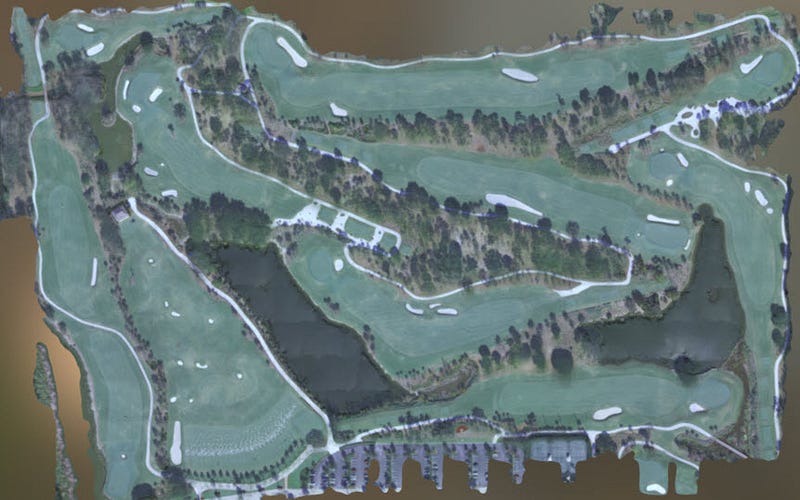
Orthomosaic map showing a full swing range and 9-holes, part of two 18-hole courses at a golf club in Florida. Angel Eyes UAV used drone technology to detect turf health problems before they became visible to the naked eye.
Drones Help Golf Course Superintendents Maintain Consistent Greens
One of the Angel Eyes UAV’s regular clients is a golf club in Florida with two 18-hole courses. The company flies the course one or two times each week, using the data they collect to help the superintendent find underlying problems with the green. In the eight months that they’ve had this contract, their work has quickly become invaluable.
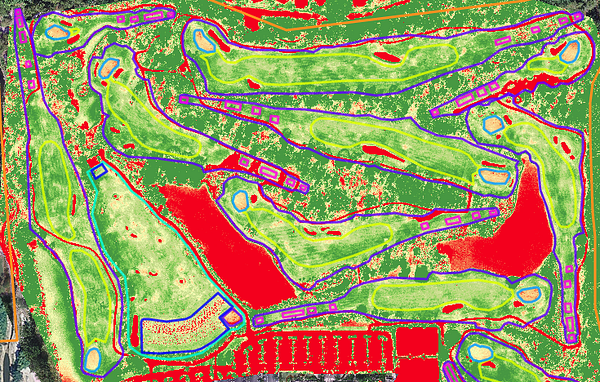
Orange areas in the Turf.Solutions map show signs of underlying stress that need to be investigated on the ground level.
Players count on golf course superintendents to keep greens healthy and consistent so that they can enjoy the best green speeds and performance. But keeping greens healthy is no small feat. If maintenance staff can spot damage from an irrigation problem or a fungus with the naked eye, that usually means the problem has already become significant and may take weeks to fully correct.
“By the time you see it,” says Stephen, “it’s usually too late.” This leaves members with a less-than-optimal course and can spell trouble for a club’s reputation.
During a recent flight, Angel Eyes UAV used a DJI Matrice 100 and multispectral sensor to collect images of the 500-acre property. Stephen knew that Turf.Solutions was the right choice to quickly and easily analyze the data.
“Most of what we use is near-infrared,” Stephen says. “What I like about Turf.Solutions is the ability to not only get our modified NDVI with the pre-defined algorithm, but also the ability to use the custom ‘slider’ to become more granular and look at specific wavelengths of reflectance. This is the only platform I know of that offers that combination of flexibility.”
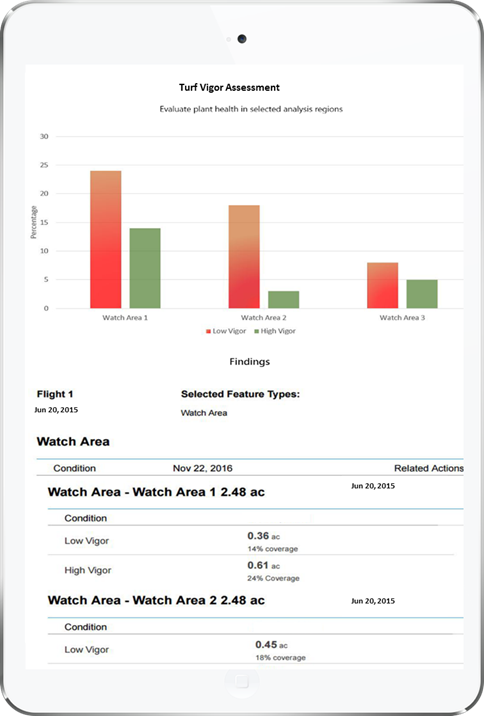
A look at the custom reporting and Turf Vigor tool available within the Turf.Solutions app that is now available on the DroneDeploy App Market
Thanks to the DroneDeploy App Market, users can now create a map in DroneDeploy and then send the information to Turf.Solutions directly from the DroneDeploy dashboard. Within 24 hours, Turf.Solutions delivers a customized, easily shareable report that analyzes turf health using an algorithm calibrated for golf course greens. Watch areas are identified and progress is monitored over time.
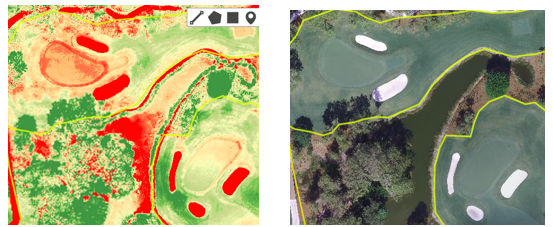
In the near-infrared imagery (left), an orange section at the top left corner indicates stressed vegetation that turned out to be an early stage of leaf fungus.
Turf.Solutions Detects Fungus Early, Reducing Treatment Time by 96%
The information Angel Eyes UAV gathered using Turf.Solutions showed several areas of possible concern. The first, seen in the picture above, was a large section of turf next to a cart path. In near-infrared imagery the section appeared orange, indicating stressed vegetation. When golf course staff visited the area on foot, it looked healthy, but additional tests revealed the presence of leaf spot, a fungus that lives in the soil and eventually spreads to grass leaves, causing brown spots and ultimately thinning the turf.
Without the use of drone technology, maintenance staff most likely wouldn’t have discovered the fungus until they saw brown spots on the green. At that stage, it takes up to eight weeks of consistent fungicide applications to eradicate it, all the while leaving a compromised green for players. But thanks to the information gathered using Turf.Solutions, the staff was able to detect the leaf spot at a very early stage and get rid of it with a less intensive treatment. They fully resolved the issue in just two days — 96% faster than if they hadn’t used drones.
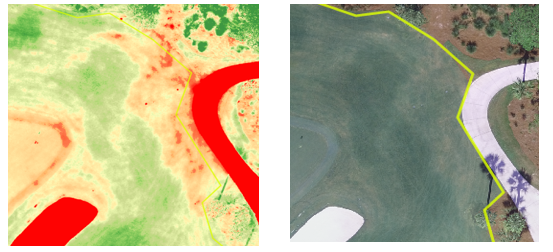
In the near-infrared imagery (left) an orange area next to the cart path shows signs of stressed vegetation. Faulty drainage was causing too much water to be diverted to one area of the green.
Drones Help Catch Drainage Issues Amidst Drought
During the same drone flight, Angel Eyes UAV made another important discovery: a small area of stress on the green that didn’t seem to be related to the leaf spot fungus. It turned out to be the result of faulty drainage, which caused some areas of the green to get too much water and other areas to get too little.
A small section of faulty drainage might not seem like a big problem, but on a golf course in drought-stricken Florida, it is. A course of this size uses 900,000 gallons of water per day to keep its greens healthy. Rationing due to draught means the course has access to only 155,000 gallons per day. When the course is operating at 15% of its ideal water capacity, every drop counts.
In the case of the Florida golf course, early detection of the problem meant the club not only saved the affected turf from dying, but it maximized the use of its already scarce water resources.
DroneDeploy and Turf.Solutions Partner for a Complete Golf Course Solution
Turf.Solutions was brought to the DroneDeploy App Market by Dronifi, a UAV software platform developed in California by New Idea Software. The company also partnered with DroneDeploy to bring FarmSolutions to the App Market.
Now that Stephen knows he can access the Turf.Solutions app from within DroneDeploy, he is excited about the possibility of using the two platforms together for an even more comprehensive package. He likes the idea of pairing DroneDeploy’s fast, accurate stitching capabilities with Turf.Solutions analysis. As he watches the commercial drone industry grow, he also sees the inherent potential for partnerships of this kind.
“I like seeing companies team and partner with each other to help out the end user,” says Stephen. “The market is huge and it’s getting bigger. If people try to do it all on their own, they are mistaken and by the time they figure it out, they’ll get leapfrogged by other companies.”
Source: DroneDeploy Blog
